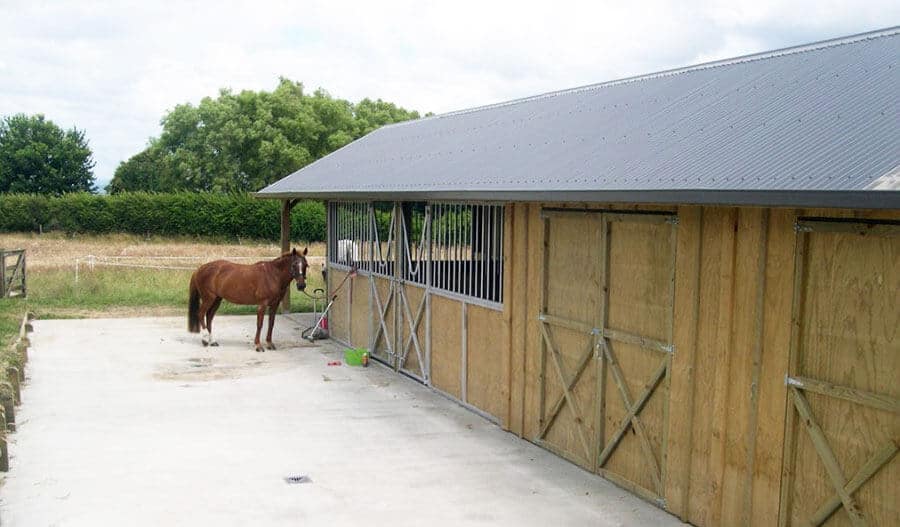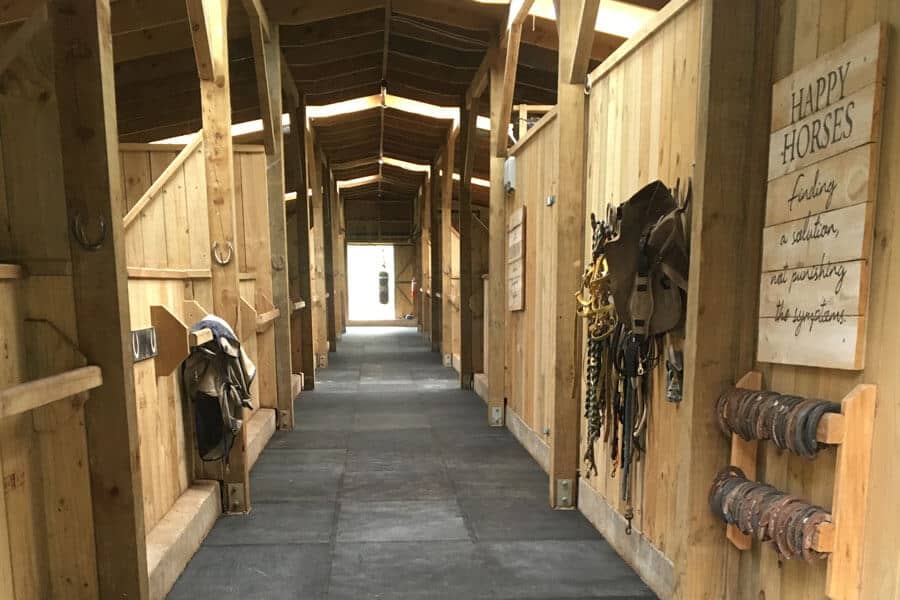How to reduce slipping in your stable

Do you have slippery flooring in your stable?
You can easily reduce slipping in your stable, walkways or wash down area by installing quality anti-slip rubber matting from Numat.
 Pictured above is a horse stable with concrete flooring and a walkway. Photo courtesy of Outpost Buildings
Pictured above is a horse stable with concrete flooring and a walkway. Photo courtesy of Outpost Buildings
Avoid slippery concrete surfaces in your stable
Concrete horse stable flooring is commonly used in large stable buildings. It is durable, easy to muck out and clean a concrete floor when compared to other materials like gravel or clay. But concrete flooring can become slippery when wet or uncomfortable for you and your horses to stand on for long periods of time.
When building a new stable, it is important to consider the different finishing options available for concrete flooring. Smoothed concrete is slippery especially when wet. Your horses will be reluctant to move around, lay down or get up. For this reason, it is not recommended for use in stalls, although it is often suitable in a feed room where its smoothness eases cleaning.
Textured concrete and broom-finished surfaces provide better traction; however, they can become smooth with wear over time. Some textured concrete surfaces can be abrasive to lying horses without a deep bedding layer. Textured concrete with a rough finish for traction and durability would be suitable in an aisleway or in wash down areas but is not recommended for use in stalls. A textured concrete surface is harder to clean and it is cold and uncomfortable for horses to stand or lay down on for long periods of time.
Concrete can be quite damp and cold, so it is important that you add something on top of it to make it more comfortable for your horses. You can add a deep layer of bedding such as sawdust, woodchip, straw or sand on top of the concrete floor. This will make it more comfortable for your horses in their stalls. Stall bedding will need to be changed regularly to avoid it getting smelly and damp. Another option to consider instead of these messy bedding options is rubber matting. Rubber matting installed on top of concrete makes the stall flooring softer, more comfortable, less slippery and warmer for your horses. You will need less bedding in your stalls if you install rubber matting.
Stop slipping and tripping on dirt or clay surfaces in your stable
Dirt or clay flooring is an affordable option for stable buildings. Choosing a dirt or clay floor is considered a natural option just as if your horse were standing or lying down in a paddock. There are some things to beware of if you are considering a dirt or clay stable floor though. In a confined stable area, dirt or clay flooring becomes much more compacted than the ground out in a paddock. It tends to be harder and can become slippery when wet. The other problem with stable floors made from dirt or clay is that the surface will become uneven over time. This can cause tripping hazards for you and your horses, especially if you have horses that pace or paw at the ground.
To improve grip and absorb urine in a stable with dirt or clay floors you can add bedding such as sawdust, woodchip, straw or sand. This bedding will need to be replaced regularly. If you would like to reduce the maintenance required on your dirt or clay stable floor you can install quality rubber matting over the top of them. This will give your horse extra grip, comfort, make it easier for you to clean out stables and reduce your bedding costs by up to 80%! You will need to make sure your stable flooring is flat and has good drainage before installing rubber mats to make sure that they sit nice and flat on the floor.
Anti-slip rubber matting for stables
Rubber matting for stable flooring will help keep your horses more comfortable and reduce slipping in your stable. Thick rubber mats are a great layer of insulation from cold temperatures and they are also a lot softer to stand or lay down on than concrete.
On Numat rubber stable matting the hoof naturally sinks into the surface, shaping to the animal’s hoof contours and giving it grip and confidence. Rubber mats are non-abrasive, which helps reduce wear and tear on horses’ hooves. Not all rubber mats are made the same but Numat’s thick rubber mats have specially designed patterned surfaces to ensure they are non-slip yet still comfortable for horses to lay down on.
Quicker to clean – Numat rubber matting has a non-porous, vulcanized rubber surface that is quicker and easier to hose down than concrete.
Rubber matting will provide a warmer, quieter, and more comfortable environment for animals and handlers. Numat stable matting comes with quality guarantees of up to 10 years so you can rest assured that they will last a long time and be well worth the investment.
Take a look at the case study about the Wilson Sisters Stable flooring below.
The Wilson Sisters Reduce Slips In Their Stable
When the Wilson Sisters noticed their horses slipping on the concrete floors in their Northland stables they went looking for a solution. They found it in the form of Numat’s Unimat stable matting.
Sisters, Vicki, Kelly and Amanda, had all witnessed horses slipping and falling on the concrete and knew they needed a high-grip solution to the problem.
With long days spent working in the stables, they needed it to be soft and forgiving on feet and legs, for both themselves and the horses.
Early on, the sisters agreed that rubber matting would be the best solution to the problem. This was because they knew it would be easy to install and would provide the softness and grip they needed underfoot.
As Kelly puts it, “Having a surface where the horses weren’t going to slip and injure themselves, like they were doing occasionally on concrete, was critical.”
After researching a few rubber matting companies the sisters contacted Numat who after a free consultation and site visit, recommended Unimat as the ideal solution.

